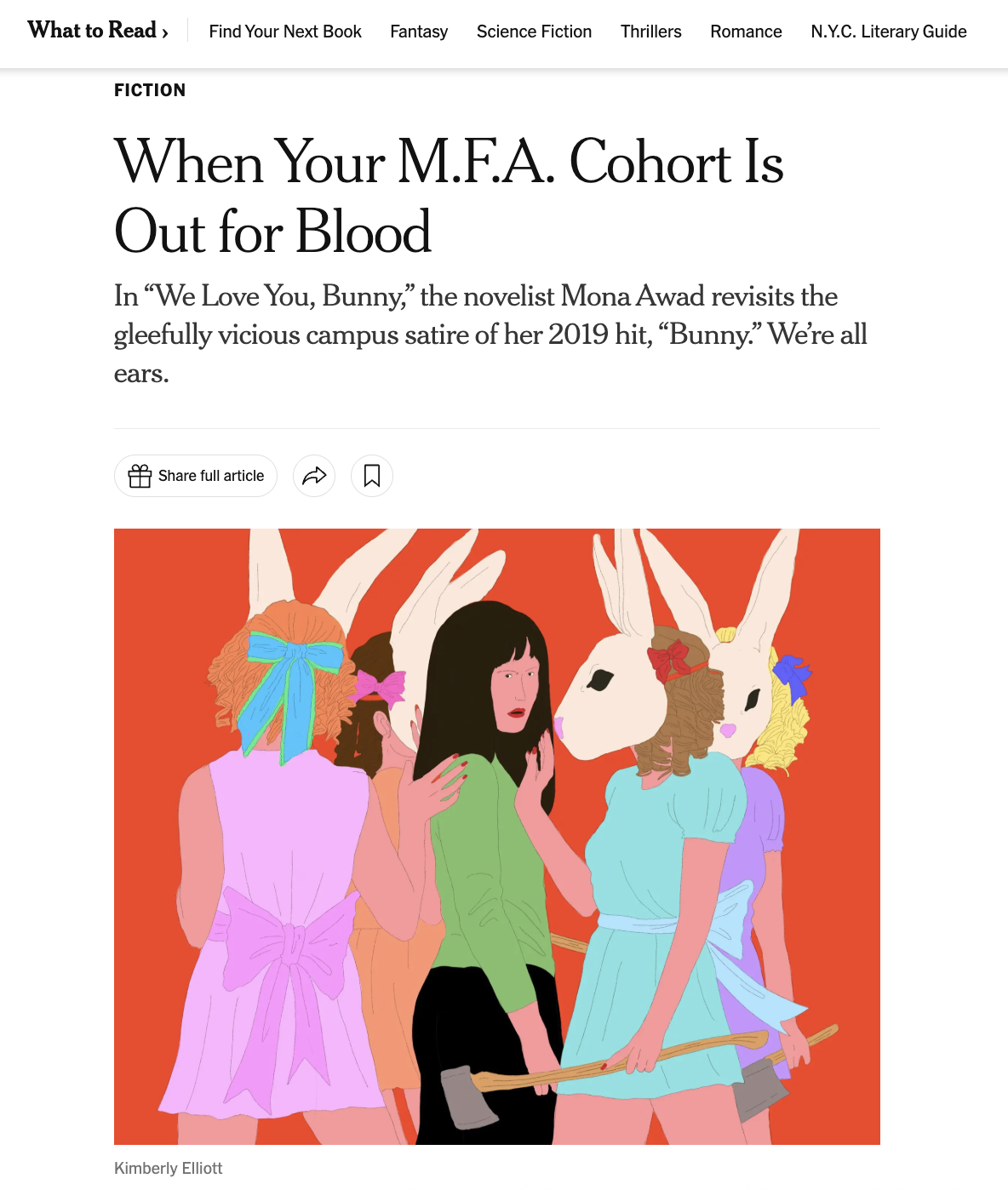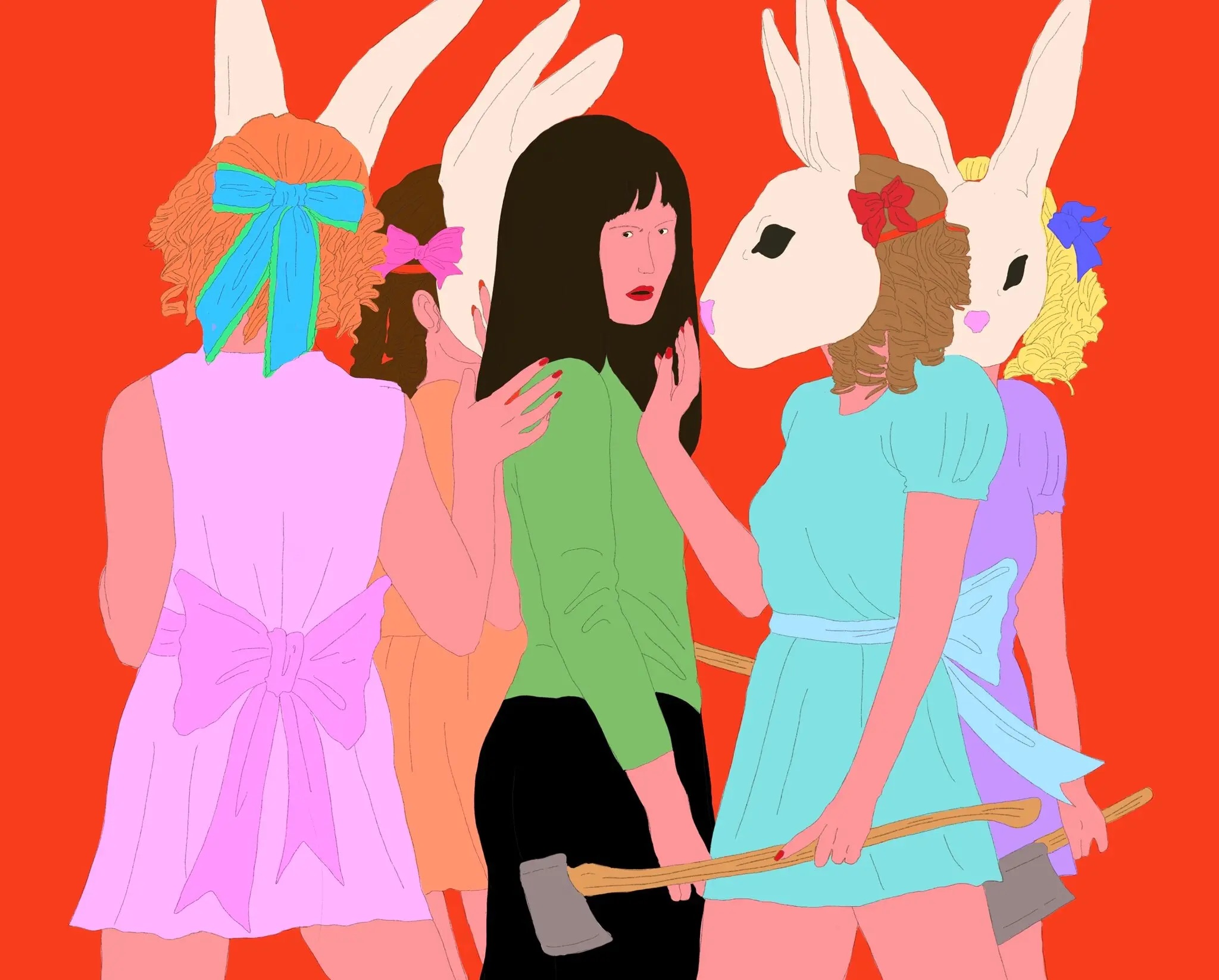When Your M.F.A. Cohort Is Out for Blood
In “We Love You, Bunny,” the novelist Mona Awad revisits the gleefully vicious campus satire of her 2019 hit, “Bunny.” We’re all ears.
Two decades ago, my creative writing program — the Midwestern one, the so-called Death Star — was a paradise for dudes. Straight guys in my cohort did hard drugs, shot out streetlights with BB guns and crossed literal tracks to visit a strip bar. (I know this because I read scads of poems celebrating these adventures.) Meanwhile, two of our professors openly dated and married female students who could have been their children. The program was a hothouse — maybe a contempt inferno.
At the time, I was reading Denis Johnson’s story collection “Jesus’ Son.” Although set in Iowa and written by an alum of the Iowa Writers’ Workshop, it has nothing to do with the program. I mentioned this to a professor who explained that Johnson never came to class. So that was the solution! I resolved to follow suit.
The result of my rebellion was, predictably, nil — save decreased exposure to air-gun sestinas. I graduated and, for better or worse, went on to become a teacher myself, including at an institution that (full disclosure) bears a resemblance to Warren, the fictional Ivy League school featured in Mona Awad’s darkly comic 2019 satire of academic creative writing, “Bunny.”
That book’s new sequel, “We Love You, Bunny,” revives its forebear’s rational, laconic narrator, the M.F.A. scholarship student Samantha Heather Mackey, a.k.a. Sam, a.k.a. Smackie, a.k.a. Cousin Itt — except here she’s no longer doing the telling, seeing as she’s gagged, trussed and being held at ax-point. Awad now addresses the reader from the collective voice of Sam’s kidnappers, the four manic-pixie trust-funders who tortured her protagonist throughout the first book.
In fact, “We Love You, Bunny” begins, quixotically enough, just after the launch of “Bunny” — which is to say, the launch of what must be a fictional version of “Bunny,” a biting and hilarious roman à clef written by Sam, not Mona Awad.
Sam’s captors have read it, by the way. They weren’t pleased, Bunny. They all say “Bunny” all the time — as an all-purpose term of endearment, an insult, a social lubricant and, possibly, a pronoun. Everyone is “Bunny” to these people because anyone can be beneath them, and everyone is expected to celebrate their ceaseless in-jokes, mediocre postmodern flash-fictions and matching “Manson girl meets Free People” dresses.
Unfortunately, for a lot of this novel we’re stuck inside these people’s heads. Bunny, it’s not always pleasant there. More salutary are the sections of the book written by Aerius, an enchanted, ax-wielding Timothée Chalamet look-alike who, without giving too much away, might be a Frankenstein’s-monster type conjured from one of those cottontail rabbits so common in certain sections of Providence, R.I. — er, I mean, the small and notably spooky New England city where Warren is located.
Awad’s great gift lies in her ability to deftly weaponize prevailing notions of good taste. She loves epithets and coins them consummately. Among the hateful Bunnies is one whom Aerius privately names “Murder Fairy” — perfect words for a girl who wants so desperately to be cute that she’ll traffic your firstborn if she’s not on the V.I.P. list for the christening. There’s a reference to “bitchy New England light”; total chef’s kiss.
Much of the novel’s humor derives from its characters’ boundless obsession with Sam’s literary splash, and it would be killjoy behavior to scold satire for lionizing its own author. That said, I admit that Awad’s enthusiasm for a Netflix-ified version of gothic — seething hearts, dagger jewelry, fever-dream prom sequences in which blood soaks corsages — sometimes made me want to beg for mercy. Her very good joke about the Free People clothing brand also replays one too many times.
Perhaps repetition is important in these days of distraction. And maybe this book is either too fun to hate or hating it is fun, even if it lacks the complexity of the original “Bunny.”
I can’t even quietly point out these foibles without falling prey to the critique Awad has carefully prepared for censorious readers: If you call her writing cheesy, you are part of the narcissistic elite. You are one of the people who don’t want Sam to succeed. You are probably reading obscure poetry not in English — or maybe something worse, like continental philosophy written after 1968, and by an ax murderer to boot.
One criticism Awad doesn’t seem to anticipate, though, concerns the novel’s puzzling handling of violence. Effete protesters who demand an end to on-campus slayings are repeatedly mocked. One professor reflects, ironically, in a moment of low-key brilliance or something, that his coddled, shock-averse students “take Violences so seriously these days.” Then again, the freewheeling carnage committed across the novel’s nearly 500 pages might be another trick of its unreliable narrators; perhaps a sly allegory for authorship (killing one’s darlings).
Sure, all these attention-seeking, virtue-signaling hacks and nepo babies, along with fans of sad-looking chapbooks (supreme offenders in the Bunnyverse), are easy targets, but here’s some wisdom seldom taught in school: If you aim at anything too frequently, you’ll inevitably miss the mark.
Date: September 29, 2025
Publisher: The New York Times Book Review
Format: Print, Web


Kimberly Elliott